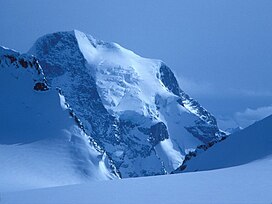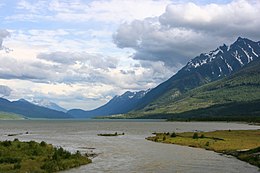Columbia Mountains
| Columbia Mountains | |
|---|---|
 Mount Sir Sandford from the Gothics Glacier | |
| Highest point | |
| Peak | Mount Sir Sandford |
| Elevation | 3,519 m (11,545 ft) |
| Dimensions | |
| Length | 741 km (460 mi) N-S |
| Width | 493 km (306 mi) W-E |
| Area | 135,952 km2 (52,491 sq mi) |
| Geography | |
Lua error in Module:Location_map at line 526: Unable to find the specified location map definition: "Module:Location map/data/South BC-NW USA-relief ColumbiaMtns wHighlands wcabinetsalish.png" does not exist.
| |
| Countries | Canada and United States |
| Provinces/States | British Columbia, Montana, Idaho and Washington (U.S. state) |
| Parent range | Pacific Cordillera |

The Columbia Mountains are a group of mountain ranges along the upper Columbia River in southeastern British Columbia, and also in Montana, Idaho and Washington. The mountain range covers 135,952 km² (52,491 sq mi). The range is bounded by the Rocky Mountain Trench on the east, and the Kootenay River on the south; their western boundary is the edge of the Interior Plateau. Seventy-five percent of the range is located in Canada and the remaining twenty-five percent in the United States; American geographic classifications place the Columbia Mountains as part of the Rocky Mountains complex, but this designation does not apply in Canada (despite a British Columbia government tourism campaign to rebrand their southern portion as the "Kootenay Rockies"). Mount Sir Sandford is the highest mountain in the range, reaching 3,519 metres (11,545 ft).
Mountain ranges
The Columbia Mountains are made up of four large ranges containing many subranges:
- Cariboo Mountains
- Monashee Mountains
- Selkirk Mountains
- Purcell Mountains (Percell Mountains in the United States)
Additionally lower areas to the west of the main ranges are sometimes included in the description of the Cariboo Mountains:
Some classification systems end the Columbia Mountains at the North Thompson River, such that the Cariboo Mountains are assigned to the Interior Plateau. Where the Columbia Mountains meet the Interior Plateau there are intermediary areas known as highlands - the Quesnel Highland (west flank of the Cariboos), the Shuswap Highland (south of the Cariboos and west of the northern Monashees), and the Okanagan Highland (west of the southern Monashees). These are listed here but are often considered to be part of the Interior Plateau.
Some geographic classifications also include the Cabinet Mountains and Salish Mountains, which lie south of the Purcells between the Kootenai River and the Clark Fork of the Columbia, but in US classification systems they are generally considered to be part of the Rocky Mountains.
Physiographically, they are a distinct province of the larger Rocky Mountain System physiographic division.
Mountains
The following mountains are the 10 highest mountains (in order) contained within the Columbian Mountains:"Columbia Mountains". Peakbagger.com.
- Mount Sir Sandford (3,519 m) (Selkirks)
- Mount Sir Wilfrid Laurier (3,516 m) (Cariboos)
- Mount Farnham (3,493 m) (Purcells)
- Mount Jumbo (3,437 m) (Purcells)
- Howser Spire (3,412 m) (Purcells)
- Mount Delphine (3,406 m) (Purcells)
- Mount Sir John Abbott (3,398 m) (Cariboos)
- Mount Hammond (3,387 m) (Purcells)
- Mount Dawson (3,377 m) (Selkirks)
- Eyebrow Peak (3,362 m) (Purcells)
Passes
The following passes are located within or on the perimeter of the Columbia Mountains:
- Cedarside Pass (Fraser and Columbia Rivers 800m)
- Canal Flats (Columbia and Kootenay Rivers)
- Rogers Pass (between Revelstoke and Golden)
- Kootenay Pass (between Trail and Creston)
- Eagle Pass (between Revelstoke and Sicamous)
- Monashee Pass (BC Hwy 6)
- Bonanza Pass (Christina Lake to Castlegar/Rossland)
References
This article needs additional citations for verification. (December 2007) |
